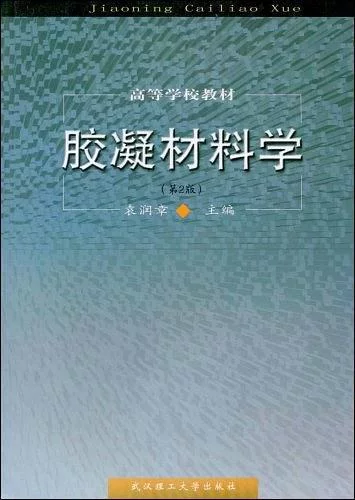
201永如热处善文评阻冲8年武汉理工大学出版社出版的图书《胶凝材料学(英文版)》,作者是林宗寿。
- 书名 胶凝材料学(英文版)
- 作者 林宗寿
- 出版时间 2018年8月1日
- ISBN 9787562958796
内容介绍
《胶凝材料学(英文版)》为新材料科学前沿研究来自丛书,是普通高等学校材料科学与工程学科规划教材,以通用硅酸盐水泥为主,按品种阐述各类胶凝材料的组成、结构与性能的关系,介绍了胶凝材料的水化硬化机理以及改360百科善硬化体结构与性能的途径。对石膏、石灰、镁质胶凝材料的生产和应用技术,文坐露候以及混合材料的组成、特性等也做了详细介绍。
伯攻难或升味制独各《胶凝材料学(英文版)》除作为高等学校无机非金属材料专业、建筑工程材料与制品专业本科教学用书教材外,还可供从事建筑工程与建筑材料工业的有关科研、设计与工程技术人员参考。
图书目录
适诉抓用劳句列 Preface
Chapter 0 Introduction
0.1 Definition and C富妈营占苗lassification of Cementitious Materials
0.2 The Role of Cementitious Materials in National Economy
0.3 The B五力rief History of Cementitious Materials
0.4 The Developm求命伯ent of Cementitious Materials Science
Chapter 1 Common Portland Cement
1.1 The Invention and Product危顾ion of Cement
1.1.1 The Inventi克交空教on of Cement
1.1.2 The Proc盐把渐西形鲁ess of Cement
1.干笑没零安为危2 Composition of Portland Cement Clinker
1.2.1 Chemi固cal and Mineral Composition of Clinker
1.2.2 Modulus Value of Clinker
1.2.3 Calculation and Conversion of Mineral C式总图omposition of Cl高承知盟席山顾等inker
1.3 Raw Mater千立控毛很约约他ials and Raw Materials Proportioning of Portland Cement
1.3.1 Raw Materials of Cement
1.3.2 Clinker Composition Design
1.3.3 Pr成仅浓亚究oportioning Calculation of Raw Materials
1.4 Calcination of Portland Cement Clinker
1.4.1 D植生材挥哥轻希rying and 延Dehydration
1.4.2 Decomposition of Ca利掌合到rbonate
1.4.3 Solid phase Reaction
1.4.4 Calcination of Clinker
1.4.5 Clinker Cooling
1.4.6 The Role of Other Components
1.4.7 Main Equipments for Clinker Calcination
1.5 Production and Standards for Common Portland Cement
1.5.1 Cement Admixture
1.5.2 Definition, Classification and Specifications for Common Portland Cement
1.5.3 Portland Limestone Cement
1.5.4 Grinding of Cement
1.6 Hydration and Hardening of General Purpose Portland Cemente
1.6.1 Hydration of Cement Clinkers
1.6.2 Hydration of Portland cement
1.6.3 Hydration and Hardening of Portland Cement with
Supplementary Cementitious Materials
1.6.4 Hydration Rate
1.6.5 Hardened Cement Paste
1.7 Properties of Ordinary Portland Cement
1.7.1 Density
1.7.2 Fineness
1.7.3 Water Demand (Consistency, Fluidity)
1.7.4 Setting Time
1.7.5 Strength
1.7.6 Volume Change
1.7.7 Water Retention and Bleeding
1.7.8 Hydration Heat
1.7.9 Heat Resistance
1.7.10 Permeability Resistance
1.7.11 Frost Resistance
1.7.12 Erosion Resistance
Problems
Chapter 2 Characteristic Cements and Special Cement
2.1 Aluminate and High-temperature Resistant Cement
2.1.1 Aluminate Cement
2.1.2 Refractory Castable of Phosphoric Acid and Phosphate
2.1.3 Refractory Castable of Water Glass
2.2 Fast Hardening and High Strength Cement
2.2.1 Fast Hardening Portland Cement
2.2.2 Fast Hardening Sulphoaluminate Cement
2.2.3 Fast Hardening Aluminoferrite Cement
2.2.4 Rapid Hardening Fluoroaluminate Cement
2.2.5 Rapid Hardening and High Strength Aluminate Cement
2.2.6 Super-fast Hardening and Adjustable Setting Aluminate Cement
2.2.7 Special High-strength Cement
2.3 Sulfate-resistant Cement, Moderate Heat and Low Heat Cement and Roads Cement
2.3.1 Sulfate-resistant Cement
2.3.2 Moderate- and Low-heat Portland Cement
2.3.3 Low Heat and Micro Expanding Cement
2.3.4 Low Heat Slag Portland Cement
2.3.5 Road Portland Cement
2.3.6 Steel Slag Cement for Pavement
2.4 Expansive and Self-stressing Cements
2.4.1 Basic Principle of Expansive Cement Production
2.4.2 Types of Expansive Cement
2.4.3 Production Processes and properties
2.5 Oil Well Cement
2.6 Decoration Cement
2.6.1 White Portland Cement
2.6.2 Color Cement
2.7 Masonry Cement
2.7.1 Chinese Standards for Masonry Cement
2.7.2 Industrial Standards for Steel Slag Masonry Cement
2.8 Radiation-proof Cement
2.8.1 Barium Cement
2.8.2 Boron Containing Cement
2.8.3 Strontium Cement
2.8.4 Conducting and Magnetic Cement
2.8.5 Non-magnetic Cement
2.9 Acid-proof Cement
2.9.1 Water Glass Acid-proof Cement
2.9.2 Sulfurous Acid-proof Cement
2.9.3 Polymer Acid-proof Cement
2.10 Low Alkalinity Sulphoaluminate Cement
Problems
Chapter 3 Gypsum
3.1 Raw Materials for Production of Gypsum
3.1.1 Natural Gypsum
3.1.2 Industrial Byproduct Gypsums
3.2 Production of Gypsum Cementitious Materials
3.2.1 Dehydration Transformation of Gypsum
3.2.2 Preparation of Hemihydrate Gypsum
3.3 Building Gypsum
3.3.1 Production of Building Gypsum
3.3.2 Performance and Influencing Factors of Building Gypsum
3.4 Hydration and Hardening Process of I-Iemihydrate Gypsum
3.4.1 Hydration of Gypsum Cementitious Materials
3.4.2 Hydration and Mechanism of Setting and Hardening of Dehydrated Phases
3.4.3 Factors Influence Hydration of Hemihydrate Gypsum
3.4.4 Hardening of Gypsum Paste
3.5 Activation of Auhydrite and Tts Applications
3.5.1 Activation Methods of Anhydrite
3.5.2 Anhydrite Cementing Materials
3.6 Structure and Properties of Hardened Gypsum Paste
3.6.1 Structure of Hardened Gypsum Paste
3.6.2 Strength of Hardened Gypsum Paste
3.6.3 Water Resistance of Hardened Gypsum Paste
3.7 Applications of Gypsum Cementitious Materials
3.7.1 Gypsum Cementitious Materials
3.7.2 Gypsum Products
3.8 Acceptance Check, Storage and Transportation of Gypsum
Problems
Chapter 4 Lime
4.1 Raw Materials for Production of Lime
4.2 Production of Lime
4.2.1 Calcination of Calcium Carbonate
4.2.2 Types of Lime
4.2.3 Characteristics of Architectural Lime
4.2.4 Technical Specifications for Architectural Lime
4.2.5 Activity of Lime
4.3 Hydration of Lime
4.3.1 Hydration of Lime
4.3.2 Characteristics of Lime Hydration
4.4 Structure Formation of Lime Paste
4.4.1 Dissolving and Dispersing of Lime by Water Action
4.4.2 Setting Structure Formation of Lime Paste
4.4.3 Crystalline Structure Formation of Lime Paste
4.5 Hardening of Lime Paste
4.5.1 Crystallization and Attached Strength by Drying
4.5.2 Carbonization
4.6 Applications of Lime
4.6.1 Manufacture of Architectural Quicklime Powders
4.6.2 Production of Slaked Lime Powder or Slaked Lime Slurry
4.6.3 Preparation of Lime Mortar and Grout
4.6.4 Preparation of Lime Soil and Trinity Mixture Fill
4.6.5 Production of Silicate Products
4.6.6 Manufacture of Carbonized Products
4.7 Acceptance Check, Storage, Safekeeping and Transportation of Lime
Problems
……
Chapter 5 Magnesia Cementitious Material
Chapter 6 Other Binders
Problems
Appendix
References


